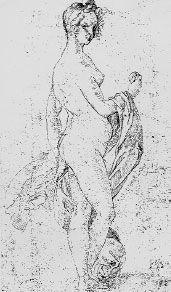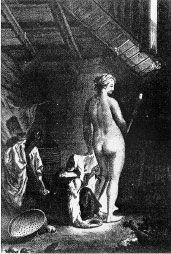Witchcraft Medicine: Healing Arts, Shamanic Practices, and Forbidden Plants (61 page)
Read Witchcraft Medicine: Healing Arts, Shamanic Practices, and Forbidden Plants Online
Authors: Claudia Müller-Ebeling,Christian Rätsch,Ph.D. Wolf-Dieter Storl

What connects these three levels of artistic examination of the witch theme is the Christian spiritual worldview. What differentiates them is the degree to which the image of the witch corresponds to the moral and theological position of the time. So, for example, artists who of their own free will draw a witch are permitted to do so because it provides an opportunity for them to depict a naked, sensuous woman under the pretext that it is really a picture of a witch. An example of this is Hans Baldung’s thematic development starting with a witches’ sabbat (see last color plate, this section) and culminating in his monumental depiction of the naked bodies of the weather-witches (above). The examples in this first category show a strong dependence on the art of antiquity, which can be seen in artists such as Dürer (less so in Baldung), who had more extensive contact with educated humanists of the time).
Many mythological picture themes of the Renaissance can be traced back to the advice of humanist advisers who sought to create a synthesis of their newly found knowledge of antiquity with their Christian position. This confrontation of Christian worldview with classical examples of witch motifs is mainly found in drawings in which the artists realized their personal idea of witches (of course these works were not created in a vacuum uninfluenced by the zeitgeist).
In the two other picture categories, all the classical concepts became totally unrecognizable through the demonizing filter of the times. These illustrations offer the most powerful theological exegesis of witches; therefore, they are the best suited for the reconstruction of the historical and political dimensions of the witch persecution.
In the many depictions of the witches’ sabbat and the witches’ kitchen created in the Dutch provinces, a more unspecific image of witches was developed. These images fed on an interest in the forbidden and depicted repulsive or seductive worlds. This interest in the aesthetic of the forbidden has more to do with the development of images of witches (the ones created under commission) than any fanatical moral and theological position.
Hans Baldung Grien (1484–1545)
From which position can we explain Baldung’s pictures of witches? How did the painter from the Upper Rhine view witches and the characteristics the Church attributed to them? Only assumptions can be made in this regard.
83
Baldung devoted himself predominantly to religious themes. However, sacred themes increasingly took a background position to secular creations and classical themes in his work, and not just because he was becoming popular with clients of the private sector. Baldung worked mostly in the Upper Rhine area. As an educated citizen with a position on the town council, he spent many years as a member of the guild in Strasbourg. In light of the entire body of his work, Hans Baldung Grien seems to have been a painter with a humanist education who could follow his own personal goals independent of court or denominational duties.
84
His drawings, engravings, and oil paintings are less revealing of any specific Christian or even heathen creed and provide more evidence of standard painterly concerns.
In general, painting in the Renaissance had emancipated itself from a denominational corset—as can be recognized in examples by most of the artists of that era. Through the writings of the humanists, the classical knowledge of man and his natural anatomy moved to center stage—even though this took place against the background of Christianity. Thus images of the naked female body became an increasingly important subject matter in Baldung’s later works. He explored traditional subject matter such as the depiction of stages of life in a more radical way. He also dealt with the transitory nature of life, which can be found in his variations on the theme in
Tod und Mädchen
[Death and the Maiden] and in Christian allegories of lust and its subsequent fallout. These generally included representations of woman depicted as Eve, as Venus, as goddess, or even as witch. Linda Hults, for whom the various stages of life speak an ambiguous language, concluded from this development that Baldung was influenced by other spiritual streams toward the end of his life rather than merely the Christian one.
85
Baldung’s depictions of naked women are open to multiple interpretations. They all depict the same type of female with long curly blond hair, similar facial expressions, and comparable body types. This same basic type can be found in the classical heathen Venus, which hangs in the Museum in Otterlo, as well as in the representation of Judith holding the decapitated head of Holofernes from the Old Testament (Nuremberg) and in his depiction of the Christian Eve (Budapest).
In this context it is good to keep in mind that we usually have not only the artists themselves to thank for the titles of the paintings, drawings, or engravings, but also the iconographic interpretation of art historians. For example, the painting that hangs in the Frankfurter Städel museum under the title
Wetterhexen
[Weather-witches] was purchased by the museum in 1879, at which time the title was changed to
Himmlische und irdische Liebe
[Heavenly and Earthly Love]. The current title has been used only since 1938. With such an unusual subject as the weather-witches the search for sketches of similar figures that appear in subsequent paintings could prove to be revealing. But in this case such a search leads only to further confusion. Without a doubt a drawing preserved in the Berlin Kupferstichkabinett can be traced to the same person who stood as a model for the standing witch. Her haughty expression, the posture of her head, and her hairstyle are noticeably similar to the coquettish over-the-shoulder-looking witch in
Zwei Wetterhexen
. However, the question of whether or not this drawing, known by the name of
Venus als Siegerin, den Apfel des Paris haltend
[Venus As Victor, Holding the Apple of Paris], actually has anything to do with the fall of Eve, or represents a sketch Baldung drew in preparation for that painting,
86
or was created on its own after the painting remains unanswered.
87

This female nude with the apple could be the model for Eve as well as for Venus, who was chosen by Paris with an apple to be the most beautiful goddess (Hans Baldung Grien, Berlin, Museen preusischer Kulturbesitz, Kupferstichkabinett.)
Frans Francken the Younger (1581–1642)
We have mentioned how a number of artists had already worked clandestinely in their private studios, with a relative amount of freedom, on the world of witches. In some cases these works even saw the light of day in engravings, where they later paved the way for other artists at the beginning of the seventeenth century to translate these sketches from graphics into paintings. An example of this is the work of Frans Francken the younger. From 1606 to about 1617 he worked on countless small-format pictures on the theme of the so-called
Hexenküchen
(witches’ kitchen), in which nearly two hundred years of witch demagogy had gathered in the heads of his contemporaries. This category includes the old witch who anoints her younger colleague for the
Himmelsflug
(sky flight),
88
and female clients from respectable circles seeking magical potions, books, skulls, frogs, and other “disgusting creatures,” as well as the inevitable witches’ cauldron, which has human legs jutting out of it, and so on.

Venus Kallipygos, she “with the pretty posterior,” was the model for this young witch, who is being anointed for flight by her aged colleague. (Maleuvre, after Queredeau,
Tableau de l’incinstance,
1612, Paris, Bibliothèque Nationale.)
The
Hexenküchen
of Frans Francken, who descended from a large dynasty of painters in Antwerp and whose craft and artistic reputation was carried on by his son, were created in the atmosphere of the Counter-Reformation. Fifteen years before Francken’s birth the reformatory iconoclasts in Antwerp created a separation between the Catholic-influenced southern provinces of the Netherlands and the reformed northern ones. In 1585, four years after the birth of the painter, the battle for religious and political freedom dominated the atmosphere as Spanish troops militarily forced the people of Antwerp to accept the Catholic creed and sixty percent of the merchants and intellectuals moved to the north. But after 1595 these groups returned in large numbers to their hometown, drawn by sinking taxes and the twelve-year armistice between Spain and the united provinces of the Netherlands—which gave not only them but also their contemporaries who remained Catholic a strengthened sense of national consciousness. In this setting of close spiritual and denominational cooperation as well as Antwerp’s commercial contacts with the lands of Spain and Portugal (both countries claimed Antwerp as a protectorate), more citizens could afford to commission artwork for their personal enjoyment. The scenes of the witches by Frans Francken must have been particularly popular, as he made countless replicas of the subject.
89
It it important to recognize that one cannot necessarily ascertain the inner position of the artist based upon the image. Despite recurring witch trials, which afflicted certain regions and times with hysteria,
90
most artists could conceal their personal viewpoints behind their work and maintain a certain distance from the prevailing influences of the times, and from their clients and benefactors.
An example of this is Lucas Cranach the elder, from whom a drawing of witches flying on goats has been preserved.
91
Like his countryman the electoral prince Friedrich the Wise, who at first was a Catholic with a fervent reverence of images of saints and relics, early on in the struggle Cranach turned to the reformer Luther and created radical anti-Roman, antipapist “battle images” of the “new belief.” Nevertheless, commissioned work existed at the same time; in other words, work was commissioned by Catholic clients and included Catholic content. Thus “old believers” such as Cardinal Albrecht von Brandenburg hired the studio of Lucas Cranach to paint for his so-called Roman Battlement—his residence in Halle—142 pictures of saints and passion plays, images that speak a language entirely different from that of Cranach’s personal drawings, as they were aimed against the creed of Luther.
92
This demonstrates not only the denominational independence of an artist such as Cranach during the first decades of the Reformation, but also that he—without heed to his personal religious persuasion—made no restrictions regarding denomination in his choice of clients and subject matter. On the other hand, we know that for Francisco de Goya, who had contact with intellectual circles during the Enlightenment, the witch—and not the witch craze—was an example of a backward world that had to be overcome. In his lithograph series he denounced the superstition and the narrow-mindedness of ecclesiastical dignitaries.
Artists repeatedly used certain clichés when depicting the witch, regardless of their personal spiritual belief systems. As independent and enlightened as these artists might have been, they were nonetheless bound to show allegiance to the Christian worldview. In this worldview only God can determine fate, health, life, disease, and death. Therefore any human who can show evidence of a magical ability to use the healing powers of nature must necessarily be viewed as an ally of demonic powers in cultures such as ours, which are shaped by Christianity. It was ironically their ability to help their fellow human beings—a truly Christian virtue—with their knowledge of plant medicine, the weather, and divination that led to the condemnation of witches. Their crime for imitating the Christ who healed the sick was to abrogate these powers decreed as the property of God alone. For this crime they suffered relentless persecution and were condemned to silence, a silence that was extended to all aspects of their craft and the great pagan tradition from which it had come—a silence that is only now beginning to lift.